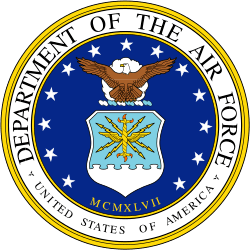Owen J. Baggett
| Col. Owen J. Baggett United States Air Force | |
|---|---|
| Born |
August 29, 1920 Graham, Texas |
| Died |
July 27, 2006 (aged 85) Texas |
| Allegiance |
|
| Service/ |
|
| Rank | Colonel |
| Unit | 9th Bomb Squadron |
| Battles/wars | World War II |
| Awards | Prisoner of War Medal |
Owen John Baggett (August 29, 1920 – July 27, 2006)[1] was a second lieutenant in the United States 7th Bomb Group based at Pandaveswar, in India, during the Second World War.
Baggett was born in Graham, Texas in 1920.[1] He graduated from Hardin–Simmons University in 1941, where he was the band's drum major.[1][2][3][4] He found employment on Wall Street after graduation.[5]
Military service
Baggett enlisted in the Army Air Corps (which was subsumed by the Army Air Forces in February 1942) and graduated from pilot training on July 26, 1942, at the New Columbus Army Flying School.[6]
On March 31, 1943, while stationed in British India, Baggett's squadron, part of the 7th Bombardment Group, was ordered to destroy a bridge at Pyinmana, Burma.[4] Before reaching their target, the 12 B-24s of 7th BG were intercepted by 13 Ki-43 fighters of 64 Sentai IJAAS.[7] Baggett's plane was severely damaged and was set on fire by several hits to the fuel tanks, and the crew was forced to bail out. The aircrew escaped the crippled B-24 merely seconds before the bomber exploded. Japanese pilots then attacked U.S. airmen as they parachuted to earth. Two of Baggett's fellow crew members were killed. (Contrary to sources stating that the pilot, Lloyd K. Jensen was "summarily executed", Jensen survived the war.[8]) Baggett, who was wounded, played dead, hoping that the Japanese pilots would ignore him. One Zero fighter approached close to Baggett, slowed and the pilot opened his canopy. Baggett drew his M1911 pistol, fired four shots at the pilot and watched as the plane stalled and plunged toward the ground.[9][10][11]
While Baggett later achieved fame as the only person to shoot down an aircraft with a pistol,[1][4][12][13][14] this was contradicted by Japanese wartime records,[7] which indicate that no Japanese pilots were lost in that particular action.[15]
Baggett survived the descent and was captured by Japanese ground forces. He remained a prisoner for the rest of the war.[1][3][16] Baggett and 37 other POWs were liberated at the war's end by eight OSS agents who parachuted into Singapore.[17]
While he was assigned to Mitchel Air Force Base, Baggett was noted for his work with children, including sponsoring a boy and a girl to be commander for a day.[18] Baggett retired from the Air Force as a colonel and later worked as a defense contractor manager for Litton.[2][4][19]
See also


References
- 1 2 3 4 5 "Owen John Baggett". San Antonio Express-News. 30 June 2006. Retrieved 21 August 2012.
- 1 2 Bethel, Brian (29 July 2006). "Owen Baggett, 85: friend of many, good drummer, one heck of a WWII tale". Abilene Reporter-News. Retrieved 19 August 2012.
- 1 2 Hayes, Harry H., ed. (April 1943). "Owen Baggett Missing In Action". Hardin-Simmons University Bulletin. p. 1. Retrieved 20 August 2012.
- 1 2 3 4 Britt Yates, Jones, ed. (April 2007). "A War, A Legend, and Forgiveness". Range Rider. Hardin-Simmons University: 50–51. Archived from the original on 2015-06-10.
- ↑ "Keeping Up With the Exs". Hardin-Simmons University Bulletin. August 1941. p. 3. Retrieved 21 August 2012.
- ↑ "Keeping Up With the Exs". Hardin-Simmons University Bulletin. October 1942. p. 3. Retrieved 21 August 2012.
- 1 2 Edward M. Young, 2012, B-24 Liberators vs Ki-43 Oscars, Botley UK, Osprey, p. 57.
- ↑ The sources regarding Lloyd K. Jensen include Baggett's own statements in the book Guests of the Emperor (p. 187) and the National Archives and Records Administration, World War II Prisoners of War Data File, 12/7/1941 - 11/19/1946.
- ↑ Thompson, Leroy (2011). The Colt 1911 Pistol. Osprey Publishing. p. 42. ISBN 1849084335.
- ↑ Pictorial history of the 7th Bombardment Group/Wing, 1918-1995. 7th Bombardment Group(H) Historical Foundation. 1998. p. 286. ISBN 096604620X.
- ↑ Kelly, Andy (2004). Magellan And I. AuthorHouse. pp. 174–175. ISBN 1418496456.
- ↑ Frisbee, John L. (1966). "Valor: David and Goliath". Air Force Magazine. 79 (7).
- ↑ "The M1911 Gets a Zero". The American Rifleman. National Rifle Association. 29 March 2011. Retrieved 19 August 2012.
- ↑ Campbell, Robert K. (2011). Gun Digest Shooters Guide to the 1911. Gun Digest Books. p. 24. ISBN 1440218943.
- ↑ Christopher Shores (2005). Air War For Burma. p. 76.
- ↑ Bourjaily, Phil (3 June 2011). "Best Shot with a 1911. Ever". The Gun Nut. Field & Stream. Retrieved 20 August 2012.
- ↑ Dorr, Robert F. (1997). 7th Bombardment Group/Wing, 1918-1995. Turner Publishing Company. p. 195. ISBN 1563112787.
- ↑ Army, Navy, Air Force Journal. 91: 156. 1953. Missing or empty
|title=(help) - ↑ Missiles and Rockets, Vol. 14. American Aviation Publications. 1964. p. 142.